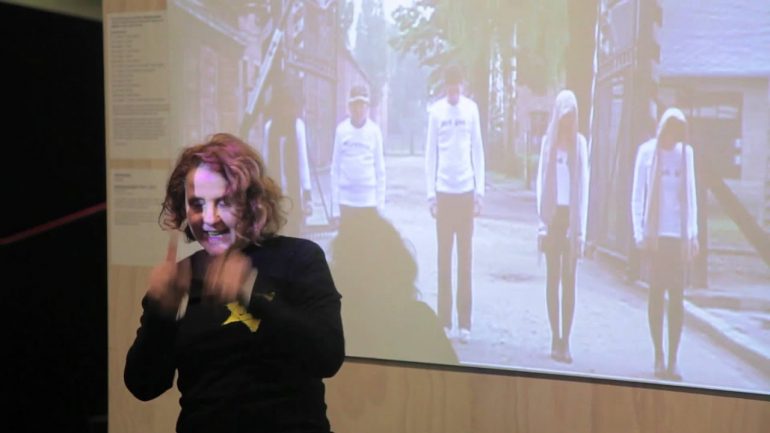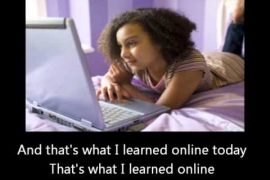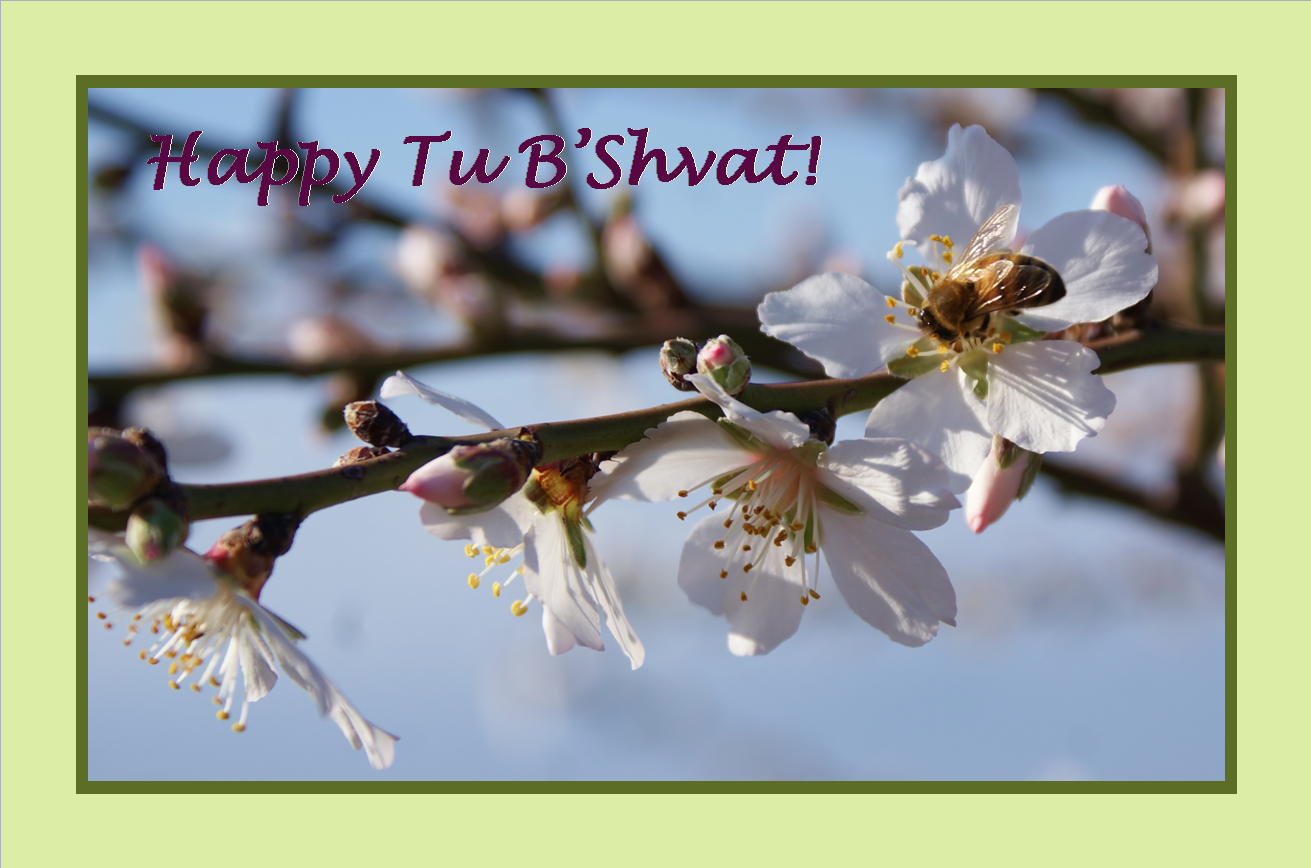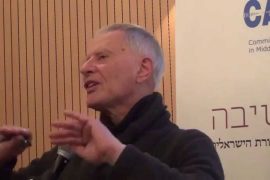Back in December we asked our loyal readers why they loved Israel and provided them the opportunity to comment below the line and express their unique Zionist passion. We also informed folks that the winner would be given the chance to pen a longer post above the line.
The winner was an Australian Jewish artist named Jane Korman. Here was her reply.
Earlier today I received a reply from Ms. Kormen which read, in part:
Hi Adam,
Firstly, I apologise for my very late reply to your email. I tried a number of times to expand on ‘Why I love Israel’ and for some reason it sounded ‘try-hard’ and so I never sent it, which I feel quite bad about.
But I was just thinking that maybe you might be interested in a talk I gave about a month ago as part of my exhibition, ’Dancing Auschwitz revisited’ at The National Gallery of Victoria (NGV studios) at Federation Square in Melbourne. The talk was titled ’JEW?!? A strip-t-shirt performance’ and I spoke about the thought process behind making ‘Dancing Auschwitz.’
I’m also attaching a transcript of the performance/talk.
I hope you enjoy it. Maybe this sums up my feelings towards Israel in an indirect way.
Thank you very much for all your extremely hard and crucial work.
Warm regards,
Jane Korman
For those of you who haven’t seen ‘Dancing Auschwitz’ I suggest you do so. While some may find the clip of Jane Korman filming her three children and her father- 89-year-old Holocaust survivor Adolk – dancing to the Gloria Gaynor song “I Will Survive” ( in front of Holocaust land-marks in Poland) offensive, I personally find it affirming and a testament to the Jews’ unquenchable spirit. As Korman put it:
“[My father] is saying ‘we’re dancing, we should be dancing, we’re celebrating our survival and the generations after me,’ – the generation he’s created. We are affirming our existence.”
Here is the video clip of her talk at the exhibition in Melbourne, followed by a transcript.
To anyone pondering what this has to do with the Guardian, as I replied to Ms. Korman; sometimes it’s not enough to simply fisk the anti-Israel lies, distortions, malice and contempt at the Guardian and ‘Comment is Free’ and to expose the institution’s complicity with antisemitism.
At times it is necessary to combat the Guardian’s endemic hostility to the Jewish state by passionately elucidating upon not merely what we oppose, but also what we affirm.
Naturally, my Aliyah was not predicated on the hope that I would one day defend Israel from the assault on her legitimacy at the Guardian but, rather, due to a broader passionate belief that (to paraphrase Ernest Hemingway) the Jewish state was a good place and worth the fighting for.
[youtube=http://www.youtube.com/watch?v=6j2-9KBQDBY&feature=relmfu]
Transcript:
April 22, 2012
What does it mean to be a Jew?
Jane’s talk at Federation Square at the MoNOW exhibition at NGV studios
Hi, and welcome.
I’m going to tell you a little about myself and my thought process that led me to the making of Dancing Auschwitz.
Dancing Auschwitz used to be a four-part installation, but today it’s a multi-part installation, which includes my 91-year-old dad, as ‘living art’. Another new addition to Dancing Auschwitz revisited is the display of a selection of the huge amount of email responses I received from around the world – arranged in groups of ‘Love’, ‘Hate’ and ‘Healing’.
So what was going through my mind before I made this work?
I’ve been an artist ever since I can remember – working and living as an artist all my life. About six years ago I went back to study Fine Art at Uni to learn what I didn’t know in the world of Art, before I left the city for the ‘simple’ life in the country.
During my Honours year at Uni, I was suddenly stuck for an idea. The only thoughts that filled my mind were those on the JEW. But I thought to myself: ‘I can’t do work on the Jew’ – it’s too difficult, too uncomfortable, too uneasy.’ But I couldn’t think of anything else to work on, because nothing seemed more urgent.
(T-shirt 1. JEW) So I made a t-shirt with the word JEW on it. I wanted to understand why this word felt so heavy, so uncomfortable and so scary. Could I really go out with this word on my t-shirt?! And what did this ‘scariness’ mean?
(Scapegoat horns) And what were the associations of being a Jew? Did it mean I was a scapegoat? So I made some scapegoat horns and wore them as I walked down the street in Ashburton.
(Nose). And then I made some accessories for my face. I made myself a big nose. I wondered, is this what it means to be a Jew (does this define me as a Jew)? (see email responses: ‘look at the kike-nose!’)
What does it mean to be a Jew? I’m aware of the propaganda, I’m aware of the stereotypes, I’m aware of what some people call Jews…but is this what it meant to be a Jew?
Thinking about this brought me back to when I was a little girl. I was walking home from school one day, and a boy yelled out and accused me of killing Jesus.
(T-shirt 2. I Didn’t Kill Jesus) I didn’t know who Jesus was when I was six. I was very upset that I was told that I had killed someone. I said I was sorry, but I didn’t kill him. So I made a t-shirt ‘I didn’t kill Jesus.’
So these are the thoughts swimming in my head – some of them – recent, some of them – throughout my life.
(T-shirt 3.Star of David symbol) That led me to thinking about this – this sign – the star of David or shield of David. It was meant to be quite a positive sign, a symbol of the Jewish people. But then it was twisted. It became a sign of humiliation and degradation that people – Jews – had to wear, and they were separated from the others and persecuted. So this symbol also made me think about ‘what it means to be a Jew’.
(T-shirt 4.Made in Australia.) Then I thought – this exhibition is about the collective Australian consciousness – and I knew that I was made in Australia. So what does that mean, together with everything else – Jew, Jesus, star of David, made in Australia…? What sort of artwork does this mixture make? And what sort of Jew was I?
(T-shirt 5.Made in Israel) That led me to thinking about Israel. I went to live in Israel thirty years ago because I married someone who wanted to live in israel. It was a very interesting – a fantastic experience. I had some kids who were made in Israel. I was straddling two worlds – Australia and Israel. I knew that Israel is the home of the Jewish people. So what did that mean? Did it help me understand what it means to be a Jew?
(T-shirt 6/7. Victim/Perpetrator) I read the newspapers, and I read that the Jews have a ‘victim’ mentality, that the Jews have been persecuted for years and years, and centuries. So does that mean I also have a ‘victim’ mentality?
And then I read – that I was also a ‘perpetrator’ (because I identify with Israel). So I didn’t know anymore. Am I a victim/a perpetrator/a victim/a perpetrator (swirling around).
All this made me more confused.
Back at uni one of my teachers saw that I was quite obsessed – as artists become. I was obsessed with the JEW topic. She said: ‘Listen Jane – I want to give you a piece of advice. I think you should go BACK to Europe, back to Poland, back to where your parents grew up, where they went to school, where they spent time in the war. Just go back! Go back because your parents are alive. You’re very lucky. Go back with your parents and go back with your children. It’s a very unique opportunity.’
I was never interested in going ‘back.’ What did Poland mean to me? But that day I went home and I spoke to my kids, and I said: ‘Hey kids, this crazy teacher’s got an idea that we should all go ‘back’ to Poland.’ And my kids said to me: ‘You know mum, this is a very special, important thing to do.’ So the trip came about. We came from different parts of the world, and we gathered together in Poland.
Meanwhile I thought – I’m an artist – I should take this opportunity to make art. So what message do I want to convey; what is important to me?
I knew one reason was related to my parents and their attitude to life. They had always celebrated life, always danced and held compulsory dress up parties for all their friends – mostly survivors. (Every one had to dress up and dance otherwise they couldn’t come to the party. These took place in the 60’s, 70‘s, 80’s and 90‘s. Mum made sure everyone had something fun to wear and organised a beautiful spread, and dad organized the music and filmed the parties.)
So I thought – we could also dance at the concentration camps – together, as a family – because that reflected my growing up years, how I was raised and what influenced me. Dancing would be a symbol of survival and a celebration of life at these horrific, loaded sites.
Then I wondered, what sort of dance should we dance? The only dance step I knew was a step I learnt when I was a teenager called ‘Ben Adam’.
And what sort of song should we use? I googled songs that sung about survival, and I chose Gloria Gaynor’s song ‘I Will Survive.‘ I felt her song is unique because it’s about minorities. Gaynor’s a black and she sings about her own freedom, and her freedom from men. The song was also sung by a group of transvestites in the movie ‘Priscilla, Queen of the Desert’ who sung about their freedom as transvestites. So I thought, ok – now it’s the Jews’ turn to use the song.
Now I had the dance, I had the song and I had the t-shirts.
(T-shirt 8. 2nd Gen) I printed ‘Survivor’ on a t-shirt for my father because he’s a survivor of Hitler’s concentration camps. (my mum too). I printed ‘2nd Gen’ for me, because that’s what a child of a survivor is called, and I printed ‘3rd Gen’ for my kids and niece, because that’s what the grandchildren of survivors are called.
The other reason I wanted to do Dancing Auschwitz was to confront people’s prejudices towards the Jews. I wanted to present my family – a family of Jews – that didn’t represent the propaganda image of a stereotypical Jew with a big nose, drooping lips and invisible horns, (as ridiculous it might seem). I wanted to present a regular family that would make people think, and hopefully shatter these perceptions.
And that’s the background to the work.
Related articles
- The stunning moral failure of the anti-Zionist left: Rachel Shabi compares Israel to European fascists (cifwatch.com)
- Has the Guardian reached the tipping point in its crusade against Israel? (cifwatch.com)
- Metula Diarist: A tribute to Guardians of the Jews (cifwatch.com)
- ‘Proud Muslim Zionist’ named Kasim Hafeez brings his message to Danny Ayalon & Israeli press (cifwatch.com)
- Harriet Sherwood cynically exploits a Holocaust survivor on Yom HaShoah to criticize Israel (cifwatch.com)
- Comment is Free, Jane Eisner & a modest question for Peter Beinart & the American Jewish Left (cifwatch.com)






